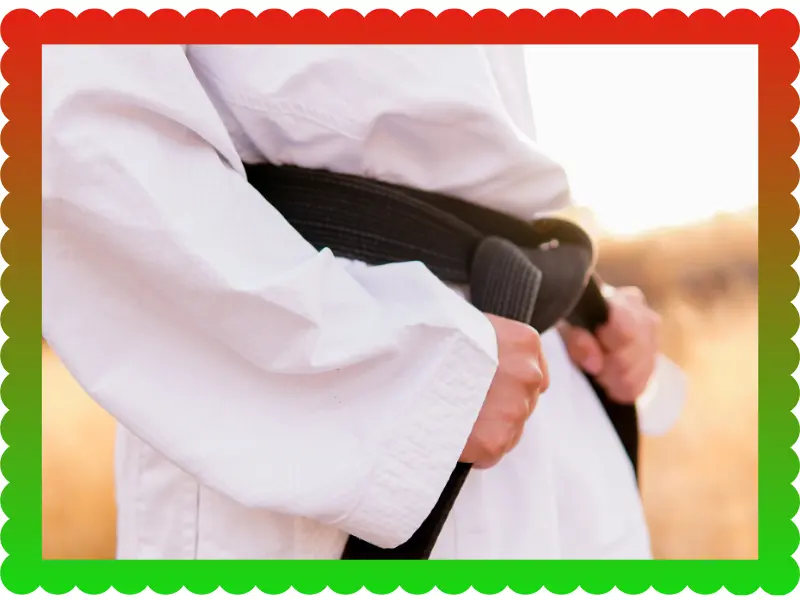
You know that feeling when you’re standing outside the dojang, hands trembling slightly, knowing your black belt test is just weeks away? I’ve been there. And let me tell you, the journey to that black belt isn’t just about perfecting your kicks or memorizing forms. It’s about transforming yourself completely.
After years of training and watching countless students prepare for this milestone, I’ve learned what truly works. Your black belt test preparation isn’t something you start a month before the big day. It’s a process that builds over time, layer by layer, like strengthening a muscle.
Understanding What Your Black Belt Test Really Means
Your black belt isn’t just a piece of colored fabric. It represents a beginning, not an ending. In Korean martial arts tradition, the black belt symbolizes the point where you’ve finally learned the basics well enough to truly start learning.
Most testing organizations evaluate you on five core areas. Your forms need to be sharp and precise. Your sparring should show control and strategy. Also, Your board breaking demonstrates power and accuracy. Your self-defense techniques prove practical application. And your knowledge of Korean terminology and martial arts philosophy shows respect for the art’s heritage.
The evaluation criteria vary slightly between schools. Some focus heavily on traditional aspects. Others emphasize modern sport applications. Understanding your school’s specific requirements is your first step.
See the latest Top-Rated Adjustable Dumbbells Set Price Today Used by Champions.

Creating Your Training Timeline for Black Belt Test Preparation
I recommend starting your focused preparation at least three months before test day. This gives your body time to adapt and your mind time to absorb everything without panic.
Break your timeline into phases. The first month focuses on identifying weaknesses. Spend time on every form, every kick, every technique. Notice what feels uncomfortable. Those uncomfortable spots are your growth opportunities.
Month two is about refinement. Take those weak areas and work them daily. If your side kick wobbles, practice it fifty times each training session. If your form has a section where you hesitate, run through it repeatedly until it flows naturally.
The final month shifts to consistency and confidence building. You’re not learning anything new now. You’re polishing what you already know until it shines.
At Taekwondoking, we’ve seen students succeed most when they follow structured preparation programs. The ones who plan their training weeks in advance rarely stumble during testing.
Mastering Your Poomsae and Forms
Your forms are the heart of your test. Each movement tells a story of combat applications and principles passed down through generations.
Start by breaking each form into smaller sections. Don’t try to perfect the entire form at once. Master the first four movements until they’re automatic. Then add the next four. This sectional approach prevents you from practicing mistakes.
Film yourself regularly. What you think you’re doing and what you’re actually doing often differ dramatically. That video doesn’t lie. Watch it with critical eyes. Are your stances deep enough? Do your blocks actually protect your centerline? Is your chamber position consistent?
Practice your forms at different speeds. Slow motion practice reveals timing issues and balance problems. Full-speed practice builds the muscle memory you’ll need during your test when adrenaline kicks in.
Pay attention to transitions between movements. Many students perform individual techniques well but stumble between them. The transition is where your understanding shows.
Building Physical Conditioning and Stamina
Your black belt test will push your endurance limits. Most tests run two to four hours with minimal breaks. You need to prepare your body for sustained effort.
Cardiovascular training becomes crucial. Running builds baseline endurance. But add interval training too. Sprint for thirty seconds, jog for ninety seconds, repeat. This mimics the intensity fluctuations of your actual test.
Your leg strength determines everything in Taekwondo. Deep stances during forms, powerful kicks during sparring, explosive breaks during board breaking – all demand strong legs.
Incorporate bodyweight exercises daily. Squats, lunges, and wall sits build the specific strength you need. Don’t overlook core training. Your punches, kicks, and balance all originate from your center.
Flexibility directly impacts your technique quality. Static stretching after training, when your muscles are warm, gradually increases your range of motion. Dynamic stretching before training prepares your body for movement.
The students at Taekwondoking who train consistently five to six days per week show dramatically better test performance than those who cram their training into two or three intense sessions.
Developing Sparring Skills and Strategy
Sparring tests your ability to apply techniques under pressure. It’s controlled chaos, and you need to be comfortable in that chaos.
Practice with partners of different sizes and styles. Tall fighters require different strategies than short ones. Aggressive fighters demand different responses than defensive ones. Variety in your training partners prepares you for uncertainty.
Work on your timing and distance management. Knowing when to attack matters more than knowing how to attack. Too early and you miss. Too late and you get countered.
Defensive skills often get neglected. But blocks, parries, and evasions keep you safe. A good defense makes your offense possible. Practice your footwork until moving backward feels as natural as moving forward.
Control is everything during test sparring. Power without control gets you disqualified. Practice pulling your techniques, landing with precision rather than force. This demonstrates maturity in your martial arts journey.
See the latest Top-Rated Adjustable Dumbbells Set Price Today Used by Champions.

Perfecting Board Breaking Techniques
Board breaking intimidates many students. The psychology of striking through solid wood creates mental barriers. But breaking is mostly about proper technique and confidence.
Start with single boards using proper technique. Focus on impact point, body alignment, and follow-through. Your hand or foot shouldn’t stop at the board surface. You’re striking through to a point six inches beyond.
Hand positioning matters enormously. For knife hand strikes, keep your fingers together and thumb tucked. The striking surface is the meaty edge of your hand, not your pinky finger.
For kicking breaks, chamber high and extend fully. Your power comes from hip rotation and snap, not just leg strength. A properly executed turning kick breaks boards with speed rather than muscular force.
Practice on rebreakable boards first. These provide resistance without the commitment of actual wood. Once your technique feels solid, move to real boards.
Mental preparation is half the battle. Visualize successful breaks daily. See yourself striking through confidently. Your brain doesn’t distinguish between vivid imagination and reality when building neural pathways.
Studying Korean Terminology and Philosophy
Your black belt test preparation includes understanding the language and principles of Taekwondo. Most tests require you to count in Korean, name techniques, and discuss philosophical concepts.
Learn counting first. The numbers one through ten form the foundation. Then add technique names as you practice them physically. Saying “dwit chagi” while performing a back kick reinforces both language and movement.
Study the tenets of Taekwondo: courtesy, integrity, perseverance, self-control, and indomitable spirit. But don’t just memorize them. Think about how they apply to your training and daily life. Your examiner may ask you to explain these concepts.
Research Taekwondo history and key figures. Understanding General Choi Hong Hi’s role in developing the art shows respect for its origins. Knowing the significance of patterns and forms adds depth to your practice.
At Taekwondoking, instructors emphasize that black belt candidates should understand why they’re doing techniques, not just how to perform them. This knowledge separates martial artists from mere practitioners.
Mental Preparation and Overcoming Test Anxiety
Your mind can defeat you faster than any opponent. Black belt test preparation must include psychological readiness.
Visualization works powerfully. Spend ten minutes daily imagining yourself performing flawlessly. Feel the confidence, see successful techniques, hear your instructor’s approval. Your subconscious accepts these mental rehearsals as real practice.
Develop pre-test rituals. Maybe you listen to specific music before training. Perhaps you do a particular stretching routine. These familiar patterns signal your brain that it’s time to perform.
Breathing exercises calm your nervous system. When anxiety rises, focus on slow, deep breaths. Inhale for four counts, hold for four, exhale for six. This activates your parasympathetic nervous system, reducing stress responses.
Reframe your nervousness. That flutter in your stomach isn’t fear – it’s excitement. Your body is preparing to perform at peak levels. Champions feel nervous too. They just interpret those sensations differently.
Remember that your instructors want you to succeed. They scheduled your test because they believe you’re ready. Trust their judgment and your preparation.
Training Smart to Avoid Injuries
Nothing derails black belt test preparation faster than injury. Training harder isn’t always better. Training smarter protects your body while building skills.
Always warm up properly. Cold muscles tear easily. Spend ten to fifteen minutes gradually elevating your heart rate and loosening your joints before intense practice.
Listen to your body’s warning signs. Sharp pain means stop immediately. Dull aches need rest and ice. Pushing through pain doesn’t prove toughness. It proves poor judgment.
Rest days are training days too. Your muscles grow stronger during recovery, not during workouts. Schedule at least one complete rest day weekly.
Cross-training supplements your Taekwondo practice. Swimming builds cardio without impact stress. Yoga improves flexibility and balance. Strength training prevents injuries by stabilizing joints.
Proper nutrition fuels your training. Protein rebuilds muscle tissue. Complex carbohydrates provide sustained energy. Hydration affects everything from focus to flexibility. Many American students underestimate how much water they need during intense training periods.
Working with Your Instructor and Training Partners
Your black belt journey isn’t solo. The relationships you build in the dojang directly impact your success.
Ask for specific feedback from your instructor. Don’t just ask “how am I doing?” Ask “what’s my biggest weakness in this form?” Specific questions get specific, useful answers.
Film your training and review it with your instructor. They can pause and point out exactly what needs adjustment. This visual feedback accelerates improvement dramatically.
Train with senior belts regularly. Their experience offers shortcuts through common problems. They’ve already solved the challenges you’re facing. Learn from their solutions.
Help lower belts with their training. Teaching reinforces your own understanding. Explaining a technique forces you to truly understand its mechanics. Plus, helping others builds the leadership qualities expected of black belts.
Create study groups with fellow test candidates. Practice together, quiz each other on terminology, provide mutual encouragement. The support network makes the journey less isolating.
Test Day Preparation and What to Expect
The week before your test, taper your training intensity. You’re not building new skills now. You’re staying sharp while letting your body recover fully.
Prepare your uniform the night before. Make sure it’s clean, pressed, and your belt is properly tied. Pack water, any required gear, and healthy snacks.
Arrive early to the testing location. Familiarize yourself with the space. Warm up thoroughly. Visualize success one final time.
During the test, focus on the present moment. Don’t think about what’s coming next or replay what just happened. Give full attention to the technique you’re performing right now.
Expect to feel tired. Expect your legs to burn. Also, Expect your heart to pound. These sensations are normal. Push through them with that indomitable spirit you’ve been cultivating.
Show respect throughout. Bow properly. Respond loudly and clearly. Maintain eye contact with examiners. Your demeanor matters as much as your techniques.
At Taekwondoking, we remind students that the black belt test measures your growth, not perfection. Everyone makes small mistakes during testing. Recovery and perseverance matter more than flawless execution.
After Your Test: Continuing Your Martial Arts Journey
Whether you pass or need to retest, your journey continues. A black belt is truly a beginning, not a destination.
If you pass, celebrate appropriately. You’ve earned this achievement through years of dedication. But remember that first-degree black belt is just the foundation. The real learning starts now.
If you need to retest, don’t view it as failure. View it as an opportunity to strengthen areas that need work. Many of the greatest martial artists had to test multiple times. Those extra months of training only make you stronger.
Set new goals immediately. Maybe you want to compete. Perhaps you’re interested in teaching. Or you might focus on earning your second-degree black belt. Having clear next steps maintains your motivation.
Share your knowledge with lower belts. Black belts have a responsibility to help others on their journey. Teaching beginners keeps your own basics sharp while building the community.
Stay humble. That black belt doesn’t make you invincible. It means you’ve developed solid fundamentals. There’s always someone better, always more to learn. This humility keeps you growing.
See the latest Top-Rated Adjustable Dumbbells Set Price Today Used by Champions.

Your Path Forward
Black belt test preparation demands everything you have. It pushes your physical limits, challenges your mental toughness, and tests your dedication. But that’s exactly why it’s valuable.
The discipline you develop preparing for this test carries into every life area. The perseverance you build on the training floor helps you overcome challenges at work and home. The confidence from breaking boards translates into confidence handling difficult conversations.
Remember that thousands of students have walked this path before you. At Taekwondoking and dojangs across America, people just like you have faced the same fears and emerged victorious. You’re part of a global community united by shared challenges and triumphs.
Start your preparation today, not tomorrow. Every training session matters. Every form repetition builds muscle memory. Also, Every sparring round develops reflexes. The work you put in now determines your test day performance.
Trust your training. Trust your instructors. Most importantly, trust yourself. You wouldn’t be testing if you weren’t ready. That black belt is within reach. You just need to extend your hand and grab it.
Your martial arts journey has brought you to this point. All those early morning trainings, sore muscles, and small victories led here. This test is your opportunity to demonstrate growth, to show what you’ve become through years of dedicated practice.
The black belt doesn’t make you a master. It makes you a serious student, finally ready to truly study this beautiful art. Your real education begins after you tie that black belt around your waist for the first time.
Now get on the training floor. Your black belt test preparation starts with the very next technique you practice. Make it count.
FAQs
Yes, achieving a black belt is very difficult. It takes many years of hard work and dedication. The difficulty comes from the high standard of physical skill and mental discipline required.
Yes, Indian actor Akshay Kumar holds a black belt. He earned a black belt in Taekwondo.
To prepare for a belt test, you must practice your forms (Poomsae) many times. Work on your kicks, blocks, and sparring techniques. Stay healthy and get plenty of rest before the test day.
Eat a light meal rich in complex carbohydrates about two to three hours before your test. Good options include oatmeal, a banana, or whole-wheat toast. Avoid heavy, fatty, or sugary foods.
Prepare by ensuring all your material is sharp and strong. Focus on conditioning your body for endurance. Study the tenets and history of your martial art as well.
In a black belt test, you perform all your forms and techniques. You will be tested on sparring and self-defense skills. Breaking wooden boards is also a common requirement.
A black belt test can take a few hours to an entire day. It depends on the school and the required material. The testing period is long to fully check a student’s endurance and focus.
Bruce Lee was a Black Belt in Judo. He was not ranked in Taekwondo. He created his own martial art called Jeet Kune Do.
Yes, you can fail a black belt test. Examiners look for a high level of performance and commitment. If your skills, knowledge, or effort are lacking, you may be asked to retest later.
Belt testing is when a student shows their skills to a panel of senior instructors. They perform forms, techniques, and sparring. The instructors judge their performance against the standards of the next rank.
See the latest Top-Rated Adjustable Dumbbells Set Price Today Used by Champions.


Founder, Owner, and CEO of TaekwondoKing.
He is one of the top 100 martial artists in the World and among the top 20 referees in Bangladesh.
Ehatasamul Alom is an esteemed Kukkiwon Certified Taekwondo 3rd Dan Black Belt with over 15 years of experience in this dynamic martial art. Born in Rajshahi, Bangladesh, Ehatasamul’s journey with Taekwondo began at the tender age of seven. His passion led him to compete at national and international levels, where he has bagged numerous awards and honors. He is also a member of the Taekwondo National Referee Panel.
With a Bachelor’s degree in Sports Science from the prestigious Rajshahi University, Ehatasamul has a deep understanding of the technical and scientific aspects of martial arts and some other martial arts.
In 2022, Ehatasamul created the “TaekwondoKing.com” to share his knowledge, Free Resources, Values, and Real experiences. His articles focus on Taekwondo training techniques, competition strategies, Sport Products Reviews, and the art’s rich history and philosophy. He also writes about the importance of mental fortitude and discipline, key aspects of his teaching philosophy. He has already launched many sports, Taekwondo, and health-related Free online tools. His goal is to inspire both beginners and seasoned practitioners worldwide through insightful and engaging content.
If you need any help, contact Ehatasamul Alom at any time.




